| Author |
Message |
Mark T

|
 Posted: Sat 04 Dec, 2010 3:29 am Post subject: Wallace Collection A466 type XVIII Posted: Sat 04 Dec, 2010 3:29 am Post subject: Wallace Collection A466 type XVIII |
 |
|
I've recently become interested in The Wallace Collection's A466, Oakeshott type XVIII sword:

From the Wallace's page for this sword:
| Quote: | Unknown Artist / Maker
Italyc. 1460
Iron or steel, gold, bronze, copper and horn
Length: 88.3 cm
Width: 4.1 cm
Weight: 1.34 kg
Maker's mark Inlaid in copper, 18.5cm from hilt
A466
European Armoury I
History: E. Juste, 1867; comte de Nieuwerkerke; Sir Richard Wallace, 08/1871.
Further Reading: Mann, Sir J. G., Wallace Collection Catalogues: European Arms and Armour Volume II, London: The Trustees of the Wallace Collection, 1962
Norman, A. V. B., Wallace Collection Catalogues: European Arms and Armour Supplement, London: The Trustees of the Wallace Collection, 1986 |
This piece is listed in Oakeshott's Records as 'XVIII. 8' on page 179:
| Quote: | Type: XVIII
Find-place: Unknown
Collection: The Wallace Collection, London. A.466
Blade-length: 34 3/4" (88.3 cms)
Pommel-type: V
Cross-style: Clubbed and short, Style II
Date: c.1440-60
Condition: Perfect. Carefully preserved in indoor conditions. The pommel is of gilded iron, perfectly preserved; the grip of black horn equally so, but the cross is of copper, more coarsely made than the pommel and the gilding looks different. Some suspicion has recently been cast upon it, the suggestion being that it is a 19th century replacement. There is a mark, inlaid in copper on each side of the blade. This is the second sword in the family referred to under XVIII.4 above.
Publication: Mann & Norman; Seitz, vol.I; Laking, vol.I.
- Oakeshott, E. (1991). Records of the medieval sword. Woodbridge, England: The Boydell Press. |
I was about to put out a call for more photos of this piece when I saw Julien M's fantastic pics in Peter Lyon's Al's Type XVIII thread.
Julien only posted four thumbnails there, but the detail he has captured is so wonderful, I thought it would be good to 'rescue' these by posting the links here, and let everyone see the amazing detail on this piece (as well as thank Julien for his work in capturing this!):


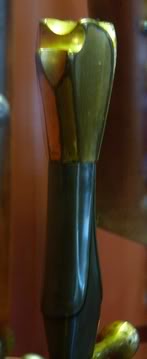
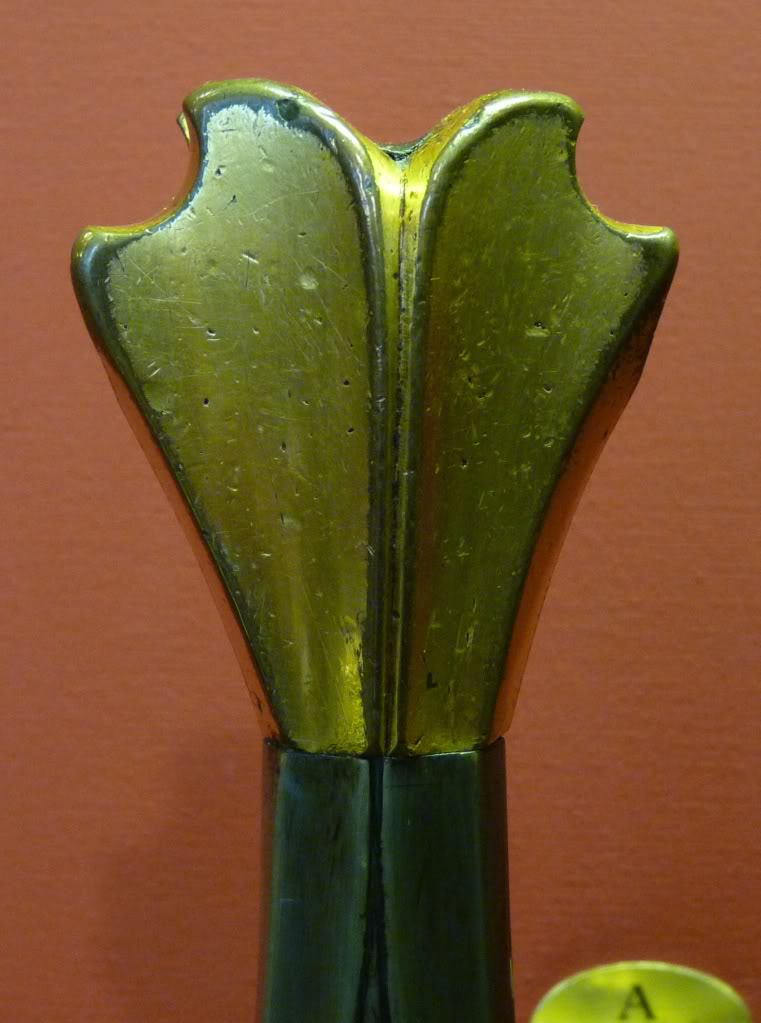

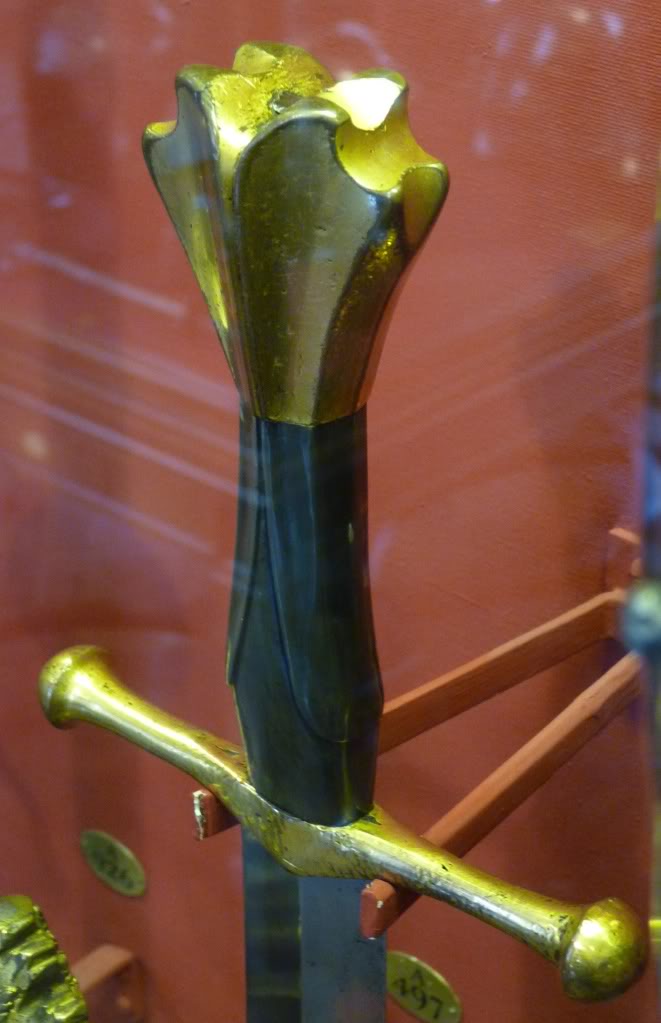
Julien M, you're a gentleman and a scholar ...
Now, some questions:
1. What else do we know about this sword? My copy of Mann's Wallace Collection Catalogues is on order ...
2. If the artist / maker is unknown (Wallace Collection), and the find-place is uknown (Oakeshott's Records), what is it that tells us this sword is Italian? Oakeshott's The sword in the age of chivalry (Woodbrige: The Boydell Press, 1964/2009), lists 'the only survivors' of this type as being in the Wallace, the Musée de Cluny, Madrid, and Zurich, with his postscript to the 1994 edition adding that the Castillon find added at least six more into circulation. He says that the Type V pommel is 'less rare in art', citing effigys in Germany and England, as well as Hans Memling's 'The Virgin and St. George'. He finishes his discussion with:
| Quote: | | Several other Flemish and German paintings show this pommel type, so much so that it is not unreasonable to suggest that it is a North-Western European rather than an Italian type. (p. 108) |
3. Did Carlo Paggiarino include the A466 in his The Wallace Collection? Carlo's detail in the Churburg book was incredible, if slightly frustrating sometimes in its 'can't see the trees for the leaves' detail ... but in studying something like the A466, and seeing the richness in detail in Julien's photos above, I can see how that could actually be a benefit.
4. What was the outcome of 'Some suspicion has recently been cast upon it, the suggestion being that it is a 19th century replacement'?
5. And, er, hands up who else likes the A466 ... 
Chief Librarian/Curator, Isaac Leibowitz Librarmoury
Schallern sind sehr sexy!
|
|
  |
 |
Maurizio D'Angelo

|
 Posted: Sat 04 Dec, 2010 6:45 am Post subject: Posted: Sat 04 Dec, 2010 6:45 am Post subject: |
 |
|
The level of detail is excellent.
With a guard like that I would be surprised that I was not Italian.
Thanks for sharing, Mark.
Ciao
Maurizio
|
|
   |
 |
Chad Arnow
myArmoury Team


|
 Posted: Sat 04 Dec, 2010 6:53 am Post subject: Posted: Sat 04 Dec, 2010 6:53 am Post subject: |
 |
|
| Maurizio D'Angelo wrote: | The level of detail is excellent.
With a guard like that I would be surprised that I was not Italian.
Thanks for sharing, Mark. |
Interesting. The guard shares a lot with guards found on English swords of the Castillion hoard.

ChadA
http://chadarnow.com/
|
|
    |
 |
Maurizio D'Angelo

|
 Posted: Sat 04 Dec, 2010 7:43 am Post subject: Posted: Sat 04 Dec, 2010 7:43 am Post subject: |
 |
|
| Chad Arnow wrote: | | Maurizio D'Angelo wrote: | The level of detail is excellent.
With a guard like that I would be surprised that I was not Italian.
Thanks for sharing, Mark. |
Interesting. The guard shares a lot with guards found on English swords of the Castillion hoard. |
My thoughts will not be absolute.
I think these guards, short and round, as well as the spherical pommel, were typical of the Mediterranean area, particularly Italy and Spain, in turn derived from eastern
I think they have a kind of imprinting, then spread to other areas.
The sword in question is already ahead with the dating.
I think that time is important. The ones you mention are posthumous, if I remember correctly.
Ciao
Maurizio
|
|
   |
 |
Chad Arnow
myArmoury Team


|
 Posted: Sat 04 Dec, 2010 8:42 am Post subject: Posted: Sat 04 Dec, 2010 8:42 am Post subject: |
 |
|
Mark,
I think this is a beautiful sword, one of the most visually splendid examples out there.
Carlo's book on the Wallace Collection does not picture this sword (unless I missed it thumbing through it just now).
Below is some more info (though most of it isn't that detailed), from various Wallace Collection Publications, including the catalogue you'll received soon.
They're in chronological order by date of publication.
 Attachment: 64.35 KB Attachment: 64.35 KB

1924 Catalogue by SJ Camp
 Attachment: 90.03 KB Attachment: 90.03 KB
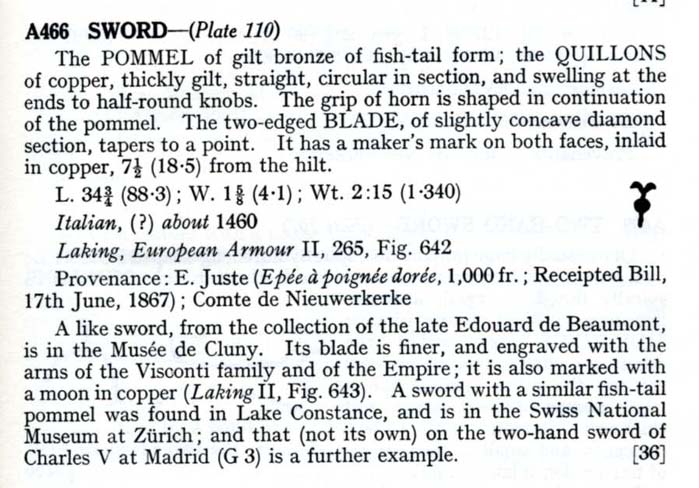
1962 Catalogue by James Mann
 Attachment: 32.98 KB Attachment: 32.98 KB
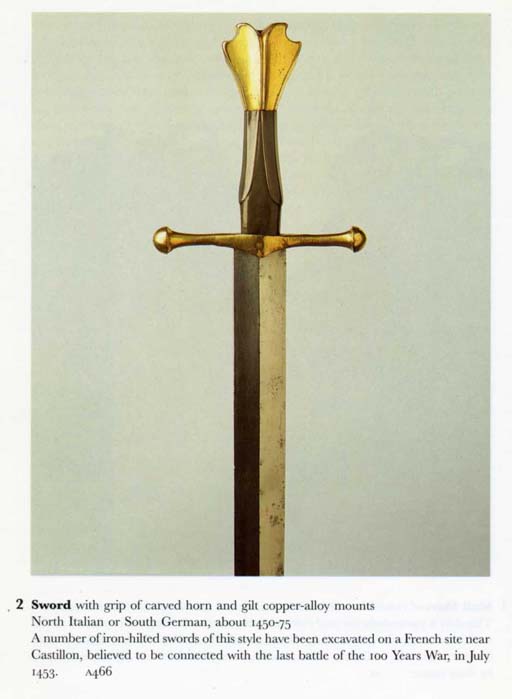
1992 Pamphlet by David Edge sold at their souvenir shop.

ChadA
http://chadarnow.com/
|
|
    |
 |
|
William Knight
Location: Mid atlantic, US Joined: 02 Oct 2005
Posts: 133
|
 Posted: Sat 04 Dec, 2010 12:04 pm Post subject: Posted: Sat 04 Dec, 2010 12:04 pm Post subject: |
 |
|
I wonder how many other horn-gripped swords there are out there? I'd always missed that detail before.
The shape of the grip is also kind of odd, it looks rather 'ergonomical'.
|
|
  |
 |
Mark T

|
 Posted: Sat 04 Dec, 2010 2:48 pm Post subject: Posted: Sat 04 Dec, 2010 2:48 pm Post subject: |
 |
|
Thanks for all the replies, and to Chad for the extra descriptions and image ... it's interesting how different lighting (such as in the photo from Edge's pamphlet) can highlight different details, even though it's not a close-up.
Now, the location and dating: curiouser and curiouser!
In 1924, Camp says 'Italian'; in 1964, Mann adds '(?)' after 'Italian', while Edge (1992) seemed confident in 'North Italian or Southern German' - he didn't preface that with 'probably', for example. Given that Oakeshott (1991) didn't give any proposal for its origin, I find it interesting that the Wallace Collection now categorically lists it as being Italian - they obviously have access to these other sources, which seem to suggest this isn't definite. I wonder if some other details came to light in more recent research there ... or if someone simply missed the question-mark in Mann, for example.
Does anyone have Norman's Supplement to the catalogues (1986) and would be happy to see if he has to say anything about it?
I'm also interested in the variance of the dates: Camp, Mann, and the current Wallace description give c. 1460, while Oakeshott places an earlier range of 1440-1460, and Edge gives the later range of 1450-1475 ... obviously, all in a roughly-similar timeframe, but I'm curious about what would have prompted Oakeshott to go early, and Edge to go late.
Fun stuff!
| William Knight wrote: | | I wonder how many other horn-gripped swords there are out there? I'd always missed that detail before. |
Me too - on both counts. Anyone ...?
| William Knight wrote: | | The shape of the grip is also kind of odd, it looks rather 'ergonomical'. |
Does anyone know if the other swords that share this kind of grip design - whether XVIIIs with V-type pommels or otherwise? Records shows the Cluny sword's pommel (XVIII. 4 (iii)) which has a different kind of shaping, and makes for an interesting comparison. Here's a pic of it posted by Dan Dickinson on Al Muckart's Accurate guard style for a fishtail pommelled XVIII.b thread.
 Attachment: 92.39 KB Attachment: 92.39 KB

image provided by Kirk Spencer via Dan Dickinson
Chief Librarian/Curator, Isaac Leibowitz Librarmoury
Schallern sind sehr sexy!
|
|
  |
 |
Chad Arnow
myArmoury Team


|
 Posted: Sat 04 Dec, 2010 3:04 pm Post subject: Posted: Sat 04 Dec, 2010 3:04 pm Post subject: |
 |
|
| Mark T wrote: | Thanks for all the replies, and to Chad for the extra descriptions and image ... it's interesting how different lighting (such as in the photo from Edge's pamphlet) can highlight different details, even though it's not a close-up.
Does anyone have Norman's Supplement to the catalogues (1986) and would be happy to see if he has to say anything about it?
Regarding horn grips:
Me too - on both counts. Anyone ...?
|
Mark,
No problem.  I have the supplement. I'll double-check it later. I have the supplement. I'll double-check it later.
On horn grips, there is this Type XV:

There may be others, but I'm on my way out the door at the moment.

ChadA
http://chadarnow.com/
|
|
    |
 |
Chad Arnow
myArmoury Team


|
 Posted: Sat 04 Dec, 2010 8:42 pm Post subject: Posted: Sat 04 Dec, 2010 8:42 pm Post subject: |
 |
|
Here's the info from the Wallace Supplement:
 Attachment: 65.2 KB Attachment: 65.2 KB


ChadA
http://chadarnow.com/
|
|
    |
 |
Julien M

|
 Posted: Sun 05 Dec, 2010 12:50 am Post subject: Re: Wallace Collection A466 type XVIII Posted: Sun 05 Dec, 2010 12:50 am Post subject: Re: Wallace Collection A466 type XVIII |
 |
|
| Mark T wrote: | | Julien M, you're a gentleman and a scholar ... |
Well Mark, what can I say, that's all very true, thanks for pointing that out  
I believe I've posted these pictures on several threads (clickable thumbnails) and the pictures are safe on my photobucket account along with many others, they are not going anywhere. Glad you like them...I had to shoot nearly 50 of these, looking like a contortionist in front of that glass enclosure to get only half a dozen good shots.
One thing these succeeded in showing is the actual width of the sword components. The design of this sword is subtle, as when looking at it facing forward, it looks very delicate while the hilt and pommel are in fact quiet heavily built and much more" bulky" than anticipated. This was a surprise to me, and in a previous discussion here this fact led to suspicion that this massive pommel had to be at least partially hollow to make up for its great size.
I am currently working on a replica of this very iconic sword,using an albion type XVIII moat blade. I've designed the hilt in balsa wood so far. I'll start a thread with pictures soon.
Cheers,
Julien
|
|
  |
 |
Zach Luna

|
 Posted: Sun 05 Dec, 2010 5:53 pm Post subject: Posted: Sun 05 Dec, 2010 5:53 pm Post subject: |
 |
|
This might be common knowledge by now, but A&A currently has a reproduction based on this sword up for sale on their "Muster" page, with a pommel molded from the original piece:
http://www.arms-n-armor.com/muster.html


I think it's a beautiful rendition of this striking artifact.
I figured others interested in this sword might appreciate this lovely bit of work from Arms & Armour.
|
|
   |
 |
Mark T

|
 Posted: Thu 09 Dec, 2010 1:30 pm Post subject: Posted: Thu 09 Dec, 2010 1:30 pm Post subject: |
 |
|
Hi Zach,
Thanks for adding those pics to this thread. That sword is what got me interested in researching the original - I'd not really been drawn to type V ('fishtail') pommels before, but to see the detail and the complex lines on Arms & Armor's reproduction really gave me a different perspective.
For the sake of completeness of the thread (and because the info won't be on A&A's site for much longer), I'll copy their text about the sword here - it makes an interesting point about those complex lines:
| Arms & Armor wrote: | 15th C. Knightly Sword
A singularly beautiful knightly sword of the 15th century. This piece is based on the sword in the Wallace Collection in London. The pommel is a strikingly three-dimensional fishtail form molded from the original. The guard of steel is similar to several from the family of swords in this style. The blade is 1650 steel tempered to a period hardness and sharpened to a fine edge.
The grip is carved to enhance the shape of the pommel and is covered in a rich brown leather. This piece is an excellent example of the challenges facing the modern replicator of swords. The pommel is as the original maker shaped it but it makes it difficult to create a sword that looks aligned in all planes. The two faces of the pommel align to different medial line, so one most shape and form the parts to divide differences.
Even with its unique symmetry this elegant sword is an exceptionally good looking piece that illustrates the craft and beauty of the original medieval craftsman.
Overall L: 41.6" Blade L: 34.8" BP: 5" Weight: 2.7 pds
SOLD |
Did your post made someone pull the trigger, Zach? Someone in the world now has a very beautiful sword!
| Chad Arnow wrote: | | Here's the info from the Wallace Supplement: |
If anyone has copies of those artworks given in the Supplement, it would be great to add them to this thread. I'm busy for the next few days, but will see what I can find if no-one else has them to hand.
Thanks again to all for making this such a well-rounded and informative thread!
Chief Librarian/Curator, Isaac Leibowitz Librarmoury
Schallern sind sehr sexy!
|
|
  |
 |
Mark T

|
 Posted: Fri 10 Dec, 2010 9:42 pm Post subject: Posted: Fri 10 Dec, 2010 9:42 pm Post subject: |
 |
|
Here are some of the images mentioned in the sources above for Type V ('fishtail') pommels in period art. While they're not images of the Wallace A466 as such, I think they add to our knowledge about this type of sword, show indicative date ranges for when this type was common, and provide a visual reference for what Mann, Oakeshott, and Norman refer to in their references/comparisons.
Hans Memling, The Virgin and Child with Angel Saint Georges and Donor,1470-1480:

 Attachment: 128.41 KB Attachment: 128.41 KB
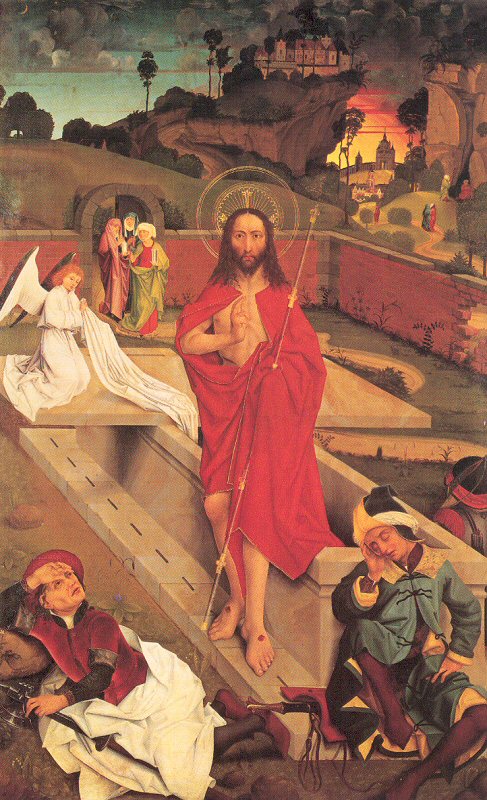
The Resurrection of Christ, Hans Pleydenwurff (c. 1465-1470)
 Attachment: 128.54 KB Attachment: 128.54 KB
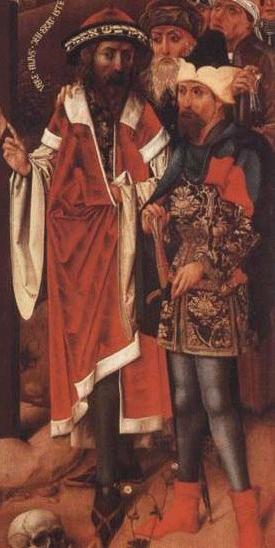
Detail from The Crucifixion, Hans Pleydenwurff (c. 1465-1470)
Chief Librarian/Curator, Isaac Leibowitz Librarmoury
Schallern sind sehr sexy!
Last edited by Mark T on Fri 10 Dec, 2010 10:50 pm; edited 1 time in total
|
|
  |
 |
Mark T

|
 Posted: Fri 10 Dec, 2010 10:48 pm Post subject: Posted: Fri 10 Dec, 2010 10:48 pm Post subject: |
 |
|
Here's another by Michael Pacher, c.1465-1470, courtesy of Wikimedia Commons:
| Quote: | | Saint Catherine of Alexandria, wearing her crown (as an attribute of her victory and martyrom) and holding the instruments of her martyrdom, a sword and a broken wheel. From a panel of an altarpiece in the Tiroler Landesmuseum Ferdinandeum, Innsbruck, Austria. |
 Attachment: 136.6 KB Attachment: 136.6 KB

Chief Librarian/Curator, Isaac Leibowitz Librarmoury
Schallern sind sehr sexy!
|
|
  |
 |
Mark T

|
 Posted: Fri 10 Dec, 2010 11:10 pm Post subject: Posted: Fri 10 Dec, 2010 11:10 pm Post subject: |
 |
|
And, while we're collating comparisons / reference points for the Wallace A466, here's another image of the Cluny sword, Oakehott's XVIII. 4 (iii) in Records. Photo by Mathieu Harlaut from this thread.
 Attachment: 101.66 KB Attachment: 101.66 KB
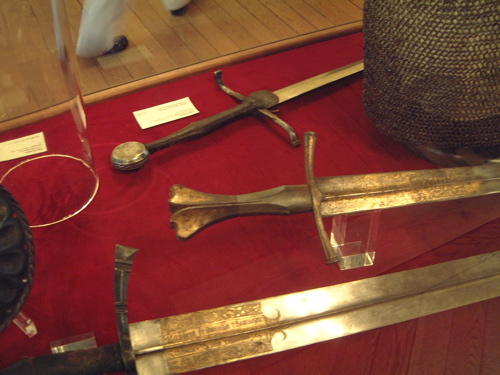
Photo by Mathieu Harlaut
Chief Librarian/Curator, Isaac Leibowitz Librarmoury
Schallern sind sehr sexy!
|
|
  |
 |
Mark T

|
 Posted: Fri 10 Dec, 2010 11:31 pm Post subject: Posted: Fri 10 Dec, 2010 11:31 pm Post subject: |
 |
|
Here's another look at the Wallace A466, from myArmoury's own spotlight article on Oakeshott Type XVIII Swords:

Chief Librarian/Curator, Isaac Leibowitz Librarmoury
Schallern sind sehr sexy!
|
|
  |
 |
Julien M

|
 Posted: Sat 11 Dec, 2010 12:13 am Post subject: Posted: Sat 11 Dec, 2010 12:13 am Post subject: |
 |
|
Hi Mark,
More shots of the Cluny fishtail taken during my last stay in Paris.




Cheers,
Julien
|
|
  |
 |
Mark T

|
 Posted: Sat 01 Sep, 2012 8:24 pm Post subject: Posted: Sat 01 Sep, 2012 8:24 pm Post subject: |
 |
|
On the question of origin on the A466 and similar types: Clive Thomas' recent article on the Castillon swords has some interesting things to say. The A466 is similar in overall design to the 'Group B' swords from Castillon. Here are the relevant quotes:
| Quote: | | Maker's marks, where they occur, are often variants of the common 'running beast' and 'crozier' marks, with a three-pointed mark perhaps resembling a crown being seen in conjunction with these on some examples. These are usually associated with the South German workshops (i.e. Passau and environs), and are almost always inlaid with a copper alloy such as latten/brass. (p. 49) |
| Quote: | | Outside the Castillon group, swords with pommels that resemble our Styles B-1 or B-2 [close to Oakeshott's V1 and V - MT] are mostly seen in a Western European context, and with blades often bearing South German maker's marks. This leads one to suspect that they might have been exported as complete swords from the German workshops. (p. 50) |
| Quote: | The swords of Group B are almost certainly of German origin and seem to have been exported widely. The pommel styles and crossguards of both groups are types that were very common across Eurpope at the time, and one suspects that these were the most commonly available when the swords were assembled. (p. 59)
- All quotes from 'Additional notes on the Swords of Castillon', Clive Thomas, The Spring 2012 London Park Lane Arms Fair [catalogue], Thropton, England: David A. Oliver, 2012, pp. 40-63. |
So, while reasons for assigning the A466 as Italian might be valid but not entirely clear (and we have Edge's assignation of possible German origin), we do know that this general form, which Oakeshott called J-type family swords, were common across Europe, commonly produced in southern Germany, and shown in German artwork of the time.
I think this is important, as given the A466's common label as Italian, and some sources saying this form was English (whether due to assigning the Castillon swords to English ownership, or due to the examples of V-type pommels on English brasses, or some other reason, I'm not sure), there seemed to me a danger of not considering the type as relevant to German contexts; Clive's article will hopefully now prevent this.
Chief Librarian/Curator, Isaac Leibowitz Librarmoury
Schallern sind sehr sexy!
|
|
  |
 |
|
Carlo Paggiarino
Industry Professional
|
 Posted: Wed 09 Oct, 2013 1:19 pm Post subject: Re: Wallace Collection A466 type XVIII Posted: Wed 09 Oct, 2013 1:19 pm Post subject: Re: Wallace Collection A466 type XVIII |
 |
|
| Mark T wrote: |
3. Did Carlo Paggiarino include the A466 in his The Wallace Collection? Carlo's detail in the Churburg book was incredible, if slightly frustrating sometimes in its 'can't see the trees for the leaves' detail ... but in studying something like the A466, and seeing the richness in detail in Julien's photos above, I can see how that could actually be a benefit.
4. What was the outcome of 'Some suspicion has recently been cast upon it, the suggestion being that it is a 19th century replacement'?
|
No. I did not include it in the book. It did not make into the final selection because part of the hilt is not original.
Regarding your observations I would like to say that I do always go for the leaves and not for the trees ... simply because you have tons of images showing the trees by none showing the leaves.
You should also bear in mind that, if you illustrate the full objects, it will be impossible to convey the level of details I want to show ... unless you publish a life size publication!
Best,
Carlo
|
|
  |
 |
Mark T

|
 Posted: Wed 09 Oct, 2013 4:49 pm Post subject: Posted: Wed 09 Oct, 2013 4:49 pm Post subject: |
 |
|
Hi Carlo,
Thanks for resurrecting this thread ... I'd forgotten how rich it had become!
I had since picked up your Wallace book, and enjoy it very much ... and have come to have a much better appreciation for the details you capture so well!
Regards,
Mark
Chief Librarian/Curator, Isaac Leibowitz Librarmoury
Schallern sind sehr sexy!
|
|
  |
 |
|
|
You cannot post new topics in this forum
You cannot reply to topics in this forum
You cannot edit your posts in this forum
You cannot delete your posts in this forum
You cannot vote in polls in this forum
You cannot attach files in this forum
You can download files in this forum
|
All contents © Copyright 2003-2025 myArmoury.com — All rights reserved
Discussion forums powered by phpBB © The phpBB Group
Switch to the Basic Low-bandwidth Version of the forum
|

